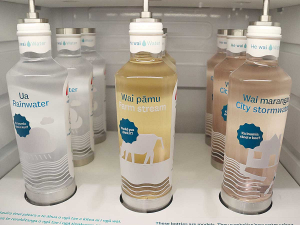Te Papa muddying the waters
Debate over Te Papa’s controversial exhibition on water quality has farmers continuing their criticism and the museum defending its stance.
 The Te Papa display showing artificially coloured water supposedly from different parts of the country.
The Te Papa display showing artificially coloured water supposedly from different parts of the country.
Museum of New Zealand, Te Papa Tongarewa has made no new friends in the dairy sector with its farcical display of water quality ‘samples’ from around the country.
The furore erupted a month ago after National MP Todd Muller tweeted a picture of a bottle of brown water, part of a display in the museum’s Te Taiao Nature exhibition.
The bottle featured an image of a cow defecating in a waterway and a map indicating the water was from the Waikato.
To their credit, Te Papa changed the label to show the cow standing on solid ground and no longer defecating. The map had also been removed and a note been added to the display to make it clear the bottles were not samples but only symbolic.
However, farmers are rightly asking how and why the Te Papa got it wrong in the first place?
It could have asked DairyNZ. After all, only days earlier they had hosted (and most likely charged NZ dairy farmers a hefty sum) a dinner for the annual Dairy Environment Leaders Forum to celebrate the great work dairy farmers had undertaken.
Farmers were upset the museum had used dyed brown water in the display, rather than taking an actual sample from a farm stream.
The display was an unfair body blow to the New Zealand farmers and the dairy sector, at a time when they are striving to win public support and recognition for the hard work they have done over the years to restore water quality on farms.
Farmers demanded to know when and where this water was taken from. Te Papa confessed that the water wasn’t actually from a farm at all but was made up in a back room using brown dye. It is clear that the water in their display is not representative of an average farm stream.
The group is also upset about how the bottle was labelled and how the sector was represented.
DairyNZ says the imagery on the bottle of a cow standing in water defecating is highly deceptive and entirely out of step with the reality of dairy farming in New Zealand today, “where we are proud to have fenced off 98.3% of waterways in recent years”.
“Farmers who have done the right thing and voluntarily invested their time and their money to fence off waterways and plant riparian strips deserve better than this from their national museum.”
Let’s hope Te Papa has learnt a lesson. Dairy farmers aren’t asking for much, they only seek credit for the good work done on farms around water quality.
Greenlea Premier Meats managing director Anthony (Tony) Egan says receiving the officer of the New Zealand Order of Merit (ONZM) honour has been humbling.
Waikato dairy farmer Neil Bateup, made a companion of the New Zealand Order of Merit (CNZM) in the New Year 2026 Honours list, says he’s grateful for the award.
Another Australian state has given the green light to virtual fencing, opening another market for Kiwi company Halter.
Farmer interest continues to grow as a Massey University research project to determine the benefits or otherwise of the self-shedding Wiltshire sheep is underway. The project is five years in and has two more years to go. It was done mainly in the light of low wool prices and the cost of shearing. Peter Burke recently went along to the annual field day held Massey's Riverside farm in the Wairarapa.
Applications are now open for the 2026 NZI Rural Women Business Awards, set to be held at Parliament on 23 July.
Ravensdown has announced a collaboration with Kiwi icon, Footrot Flats in an effort to bring humour, heart, and connection to the forefront of the farming sector.
President Donald Trump’s decision to impose tariffs on imports into the US is doing good things for global trade, according…
Seen a giant cheese roll rolling along Southland’s roads?